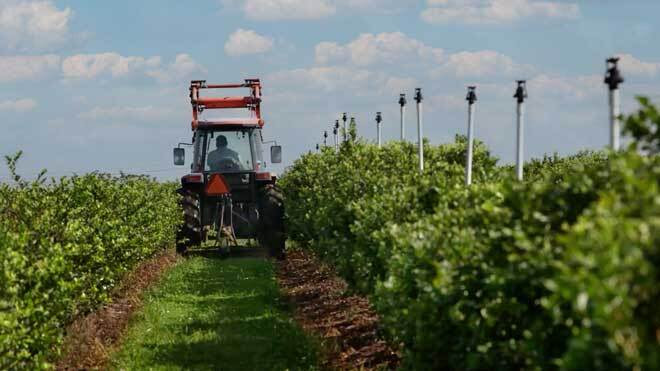 Did you know the FARMS program has helped farmers save water and money for the past two decades? FARMS stands for Facilitating Agriculture Resource Management Systems.
Did you know the FARMS program has helped farmers save water and money for the past two decades? FARMS stands for Facilitating Agriculture Resource Management Systems.
It is an agricultural cost-share reimbursement program that reduces groundwater withdrawals from the Upper Floridan aquifer through conservation and alternative water supply best management practices. Watch this video to learn what this program has accomplished during the past 20 years.
FARMS is an agricultural cost-share reimbursement program that reduces groundwater withdrawals from the Upper Floridan aquifer through conservation and alternative water supply best management practices (BMPs). In conjunction with water conservation BMPs, water quality and natural systems improvement BMPs also may be cost-shared in priority areas.
The program is designed to serve as an incentive to the agricultural community to promote water quantity, water quality and natural systems BMPs to conserve groundwater use and promote resource sustainability.
Examples of commonly used BMPs include:
- Weather stations and soil moisture sensors with telemetry
- Riser culverts and water-controlled structures
- Surface water or tailwater irrigation pumps and filters
- Remote irrigation zone controls and soil moisture and climate sensor telemetry
- Fertigation systems
- Cold protection measures
FARMS is a public/private partnership developed by the District and the Florida Department of Agriculture and Consumer Services.
Program Goals
The FARMS Program focuses on Upper Floridan aquifer withdrawal savings throughout the District as well as water quality and natural systems improvements in targeted Water Use Caution Areas and priority watersheds.
- Improve water quality within the Shell, Prairie and Joshua Creek (SPJC) Watersheds
As of July 2023, the 87 Board-approved projects located within the SPJC watershed are projected to offset approximately 11.9 million gallons per day (mgd) of groundwater through BMP implementation. An additional water resource benefit is reductions in the potential for groundwater mineralization of surface waters while improving water quality in the City of Punta Gorda’s drinking water reservoir. Prairie Creek has been removed from the list of impaired waterbodies by the Department of Environmental Protection, indicating the success of the program. - Improve natural systems in the Upper Myakka River Watershed (UMRW)
As of July 2023, nine projects have been approved and are operational offsetting 2.8 mgd through conservation and the reuse of tailwater. These projects are reducing the contribution of groundwater to this volume-sensitive basin. - Reduce groundwater use by 40 mgd within the Southern Water Use Caution Area (SWUCA)
As of July 2023, 195 projects have been approved with 174 operational projects having offset 22.4 mgd. These projects are reducing the amount of groundwater pumped from the Upper Floridan Aquifer. - Reduce groundwater use within the Most Impacted Area (MIA)
The MIA is an area specifically affected by groundwater withdrawals within the SWUCA. It’s about 700 square miles and located along the southern Hillsborough, Manatee and northwestern Sarasota counties. As of July 2023, 18 projects have been approved with 18 operational projects having offset 3.4 mgd. - Reduce groundwater use within the Central Florida Water Initiative (CFWI) region
Although not fully incorporated within the SWUCA, the CFWI has been identified as a priority area in which the implementation of agricultural BMPs to reduce Upper Floridan groundwater use will help to ensure future water needs are met. As of July 2023, 27 projects have been approved with 24 operational projects having offset 1.5 mgd. - Reduce cold protection groundwater use within the Dover/Plant City Water Use Caution Area (DPCWUCA)
The DPCWUCA was established in 2011 as a result of an extended freeze event in 2010 that resulted in numerous dry well complaints and sinkholes due to agricultural-related groundwater pumping for cold protection. As of March 2023, 24 projects have been approved with 21 operational projects having offset 72.4 million gallons per freeze event. - Implement agricultural BMPs to reduce groundwater use and reduce nutrient loading
As of July 2023, 15 operational projects having offset 0.7 mgd and reducing nutrient loading by approximately 5,182 pounds per year.
The approved projects support the District’s Regional Water Supply Plan, SWUCA Recovery Strategy, Strategic Plan and the Springs Management Plans.
Program Funding Qualifications
To qualify for funding, projects must be located in the District and include one or more of the following BMP strategies:
- Utilize an alternative water supply or technology to reduce groundwater use.
- Improve irrigation water quality and watershed ecology by reducing reliance on poorer quality groundwater.
Project Guidelines
- Growers manage their projects and are reimbursed for approved expenses.
- Reimbursement can amount to as much as 75 percent of total project costs with water quality and groundwater quantity savings / conservation BMPs; and as much as 50 percent with water quality or groundwater quantity savings / conservation BMPs.
- District and grower(s) enter into a signed and executed contractual agreement for the FARMS project with a contract duration generally 5–10 years.
- Growers are responsible for obtaining all project-related permits and must have District authorization prior to incurring approved reimbursable expenses.
- Permitted water use allocations are not reduced.
- More FARMS information HERE.

